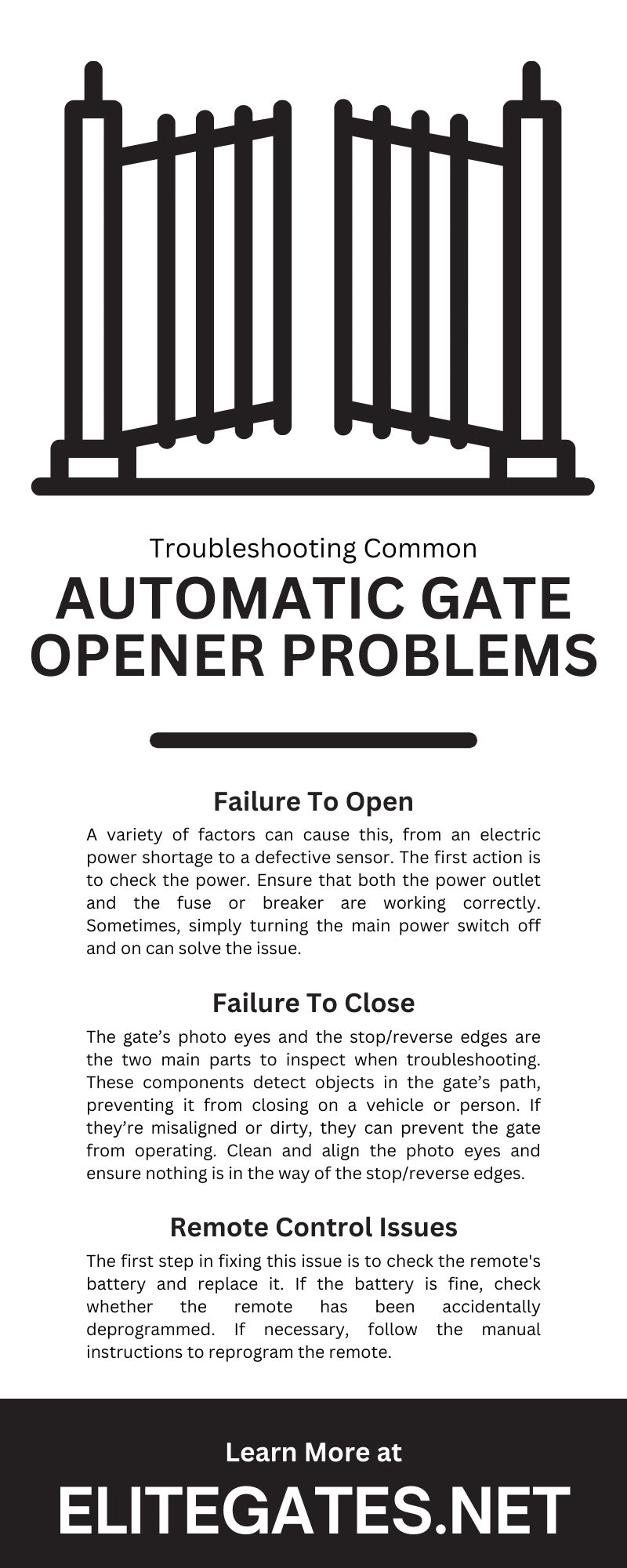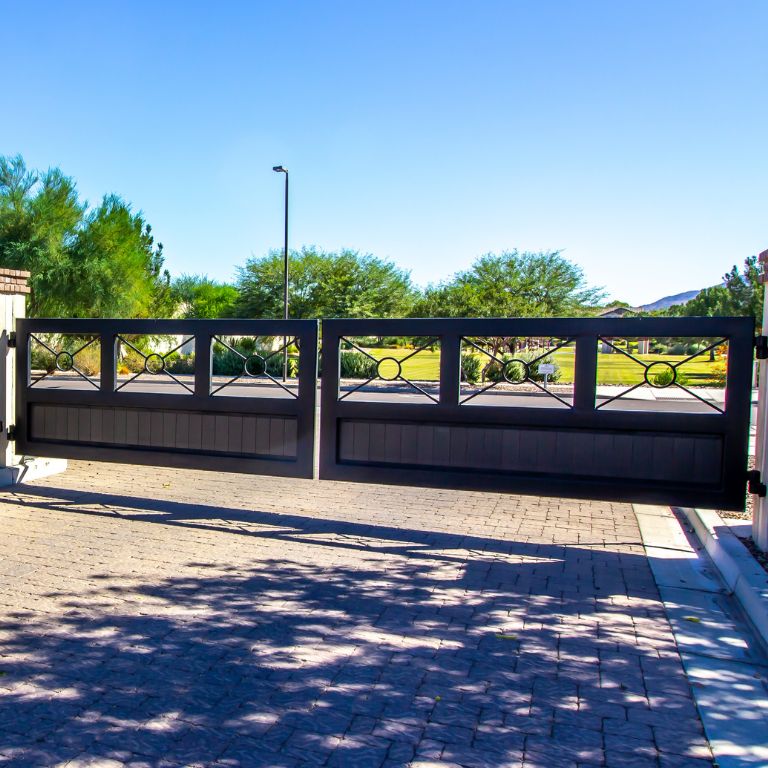When you invest in the security and convenience of an automatic gate opener, you expect smooth operation and reliability. So, it’s frustrating when you're met with a stubborn motor or a gate that just won’t budge. The persistence of certain issues can baffle even the most technically inclined individuals. That’s why we’ve compiled this comprehensive guide to help you troubleshoot common automatic gate opener problems. Here are some detailed troubleshooting steps, safety protocols, and preventive maintenance measures to keep in mind.
Failure To Open
One of the most common gate opener issues is the failure to open. A variety of factors can cause this, from an electric power shortage to a defective sensor. The first action is to check the power. Ensure that both the power outlet and the fuse or breaker are working correctly. Sometimes, simply turning the main power switch off and on can solve the issue. Next, inspect the remote control batteries and replace them if needed.
It’s also worthwhile to clean your gate’s sensors so that they can more easily detect inputs from your remote. Since these components have constant exposure to the elements, it’s common for them to collect dirt and grime. Simply wipe these particles away with a damp cloth and use your remote to test for improved movement.
Failure To Close
If your gate opens just fine but fails to close, you may have an obstruction to contend with. The gate’s photo eyes and the stop/reverse edges are the two main parts to inspect when troubleshooting. These components detect objects in the gate’s path, preventing it from closing on a vehicle or person. If they’re misaligned or dirty, they can prevent the gate from operating. Clean and align the photo eyes and ensure nothing is in the way of the stop/reverse edges.
For swing gates, you’ll need to disengage the gate and opener's clutch systems. You can do this with your model’s override, which often takes the form of a lever or pedal. Once the override is disengaged, move the gates manually to check for obstructions with the gate's alignment. Finally, check the limit switches, which determine the point to which the gate should move before stopping.
Remote Control Issues
When your gate opener is unresponsive to the remote control, it can be incredibly frustrating. The first step in fixing this issue is to check the remote's battery and replace it. If the battery is fine, check whether the remote has been accidentally deprogrammed. If necessary, follow the manual instructions to reprogram the remote.
If the remote is still not working, the system’s interference may be the culprit. Make sure there are no objects interfering with the signal, such as metal objects or electronic devices. Additionally, ensure the remote is within range and pointing toward the gate when you press the button.
If none of these solutions work, the issue might be with the receiver within the gate opener. In this case, it’s best to contact the manufacturer or a professional for further troubleshooting.
Sensor Malfunctions
The sensors on your automatic gate play a crucial role in the safety and security of your property. Doors that refuse to close despite the interior being clear can signal sensor problems. Note that there are many different types of sensors present on an automatic gate, from opening and closing sensors to underground, infrared, and microwave sensors. Each component has its own method of troubleshooting. It’s vital that you narrow down which sensor is the problem before proceeding.
Once you pinpoint which sensor is causing the issue, refer to your manufacturer’s instruction manual. This booklet will break down every part of your automatic gate opener system and describe in detail how to address problems with each specific sensor type.
Noisy Operations
Noise from an automatic gate isn’t just intrusive; it’s a sign that something, somewhere, may not be quite right. Common culprits of gate noise include worn-out gear sprockets, loose hardware, and poor gate alignment.
Inspect the gate for any visible damage or misalignment in the tracks, wheels, and support brackets. Tighten loose hardware to see if it resolves the issue. Lubricate the moving parts of the gate opener following the manufacturer’s recommendations. This can often reduce the noise significantly and even improve the speed of the gate.
Power Supply Problems
Another common automatic gate opener problem you should know how to troubleshoot involves the power supply. Automatic gate openers require a consistent power supply to operate efficiently. If you suspect a power supply issue, you should first check your electrical panel. Reset any tripped circuit breakers and replace any blown fuses. If the circuit breaker continues to trip, it's a sign of a more significant issue that may need professional assessment.
Regular visual checks of the power conduit and wiring can also identify potential problems. Always perform these checks cautiously and when the gate is not in use. Wiring that’s exposed to the elements can corrode, impeding the flow of electricity.
Gate Stuck in One Position
If you find your gate stuck in a singular position, it eliminates its effectiveness as a security measure. Start the troubleshooting process by inspecting the power supply, gate tracks, and hinges. Look for visible signs of damage and lubricate the tracks and hinges to ensure the gate can move unimpeded.
Next, consider the potential involvement of the release mechanism, often appearing as a lever or foot petal. If disengaged, it will prevent the opener from moving the gate. Refer to your manual and follow the specific steps to re-engage the release mechanism.
Finally, check the clutch mechanism, which may slip due to a heavy load or obstruction. For sliding gates, ensure the rollers aren’t stuck and that they can move along the track freely. A stuck gate can also occur from the improper setting of the limit switches, so make sure that you also check these components according to the manufacturer instructions.
For every challenge you face with your gate, there is a solution. A well-maintained gate secures your property and adds to the ease and pleasure of home living. We encourage you to take an active stance in managing your automatic gate and to shop with a top gate opener company like Elite Gate for premium parts that will help you achieve success. Our swing gate openers and other replacement parts are top-of-the-line, ensuring you can get your system back up and running again in no time.


